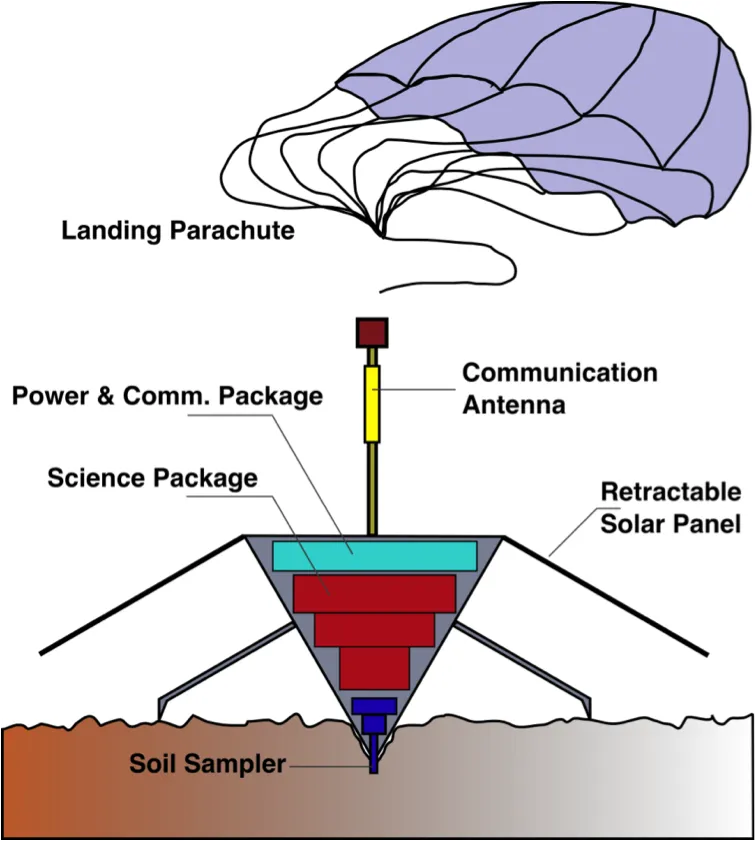Exploring Mars—With Arrows
Penetrator probes may be the perfect way to prospect for life on other planets.
/https://tf-cmsv2-smithsonianmag-media.s3.amazonaws.com/filer/32/8a/328a5fa0-3b7e-4209-9c01-9406051c4ac0/exolance_deploy.jpg)
Finding life on an alien planet will be challenging. This became clear after the Viking mission of the 1970s, the first and last extraterrestrial life detection experiment conducted to date. What makes the job even harder is that we’ll need to search not just on planetary surfaces, but also below the ground in places like Mars and Jupiter’s moon Europa. NASA’s Curiosity rover has a drill, but can only drill down a few centimeters, while Europe’s planned ExoMars mission will be able to drill down about two meters.
There’s another option for exploring a planet’s subsurface, however. The non-profit group Explore Mars is asking for donations to develop a project called Exolance, which would use small, lightweight penetrator probes (called “Arrows”) to deliver life detection instruments at least five meters below the Martian surface. The project team includes planetary scientist Chris McKay from NASA’s Ames Research Center and Gil Levin, a former principal investigator for a life detection experiment on the Viking landers. In some ways, Exolance combines the strengths of Viking and Curiosity. A very similar approach, called BOLD, for Biological Oxidant and Life Detection Mission, was suggested a few years ago by a research group that I headed.
Penetrators have the advantage of being able to land in locations most interesting to astrobiologists—for example, the topographically lowest areas of Valles Marineris, where liquid water should be stable on the surface and where traditional landers have a hard time reaching due to narrow canyon walls and treacherous atmospheric conditions. And since penetrators are cheaper than landers, you could send several of them as insurance in case one or more fails.
The critical engineering problem is the landing. The hard, fast landing envisioned by Exolance’s creators requires that the life detection instruments and communication equipment be rugged enough to survive the impact (NASA’s Deep Space 2 penetrator failed to establish radio contact after slamming into Mars in 1999). Our BOLD mission proposal envisioned landing the probes with the help of parachutes to soften the impact (as in the illustration below), at the expense of a lesser penetration depth.

Penetrators don’t only have application at Mars. They would also be extremely useful for icy moons like Europa, where liquid water is suspected to exist beneath an icy shell. If life exists in pockets of liquid water below the surface, a penetrator could pass through the radiation- reworked upper meter of ice, and probe for life or remnants of life encased in the ice. A research team including Alan Smith from University College London tested such a penetrator on a 10-ton cube of ice to simulate the surface of Europa, and showed that the probe could survive such an impact. This kind of early engineering work supports the notion that penetrators may be a promising alternative to look for life in places that landers and rovers have a hard time reaching.
Here’s a presentation on Exolance from the recent Humans to Mars summit in Washington DC:
/https://tf-cmsv2-smithsonianmag-media.s3.amazonaws.com/accounts/headshot/Dirk-Schulze-Makuch-headshot.jpg)


/https://tf-cmsv2-smithsonianmag-media.s3.amazonaws.com/accounts/headshot/Dirk-Schulze-Makuch-headshot.jpg)